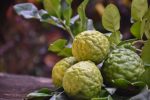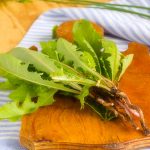
Dandelion leaf (Taraxacum officinale , Web.) finds its way into beverages because of its claim to be a natural weight-loss ingredient. Dandelion has been used in European, Chinese, Mexican and North American folk medicines.
The leaf has been used in salads and teas to add flavour. There are a number of species from the genus to be found including T. vulgare, dens-leonis and Leontodon taraxacum. Other folk uses for this ‘weed’ include treatment for dyspepsia, heartburn, gallstones, hepatitis, liver, spleen and bile problems, as it has choleretic (bile stimulating) properties, as a diuretic (Clare et al., 2009), treatment of infections and even cancers especially breast and uterus. There is some evidence for its use in treating anorexia. There has been a rabbit study which suggests that feeding with dandelion root and leaf reduced hypolipidemia and offered possible protection against atherosclerosis (Choi et al., 2010).
There are a variety of components to be found in T. officinale include well-known antioxidants such as quercetin, chlorogenic acid luteolin and its derivatives (Williams et al., 1996; Kisiel and Barszcz, 2000; Hu and Kitts, 2004), scopoletin and caffeic acid. There are two interesting coumarins to be found in the leaf, cichoriin and aesculin, which are the 7- and 6- glucosides of aesculetin (6,7-dihydroxycoumarin) (Williams et al., 1996). Luteolin and its 7-linked glucoside have been shown in cell studies to inhibit prostaglandin E2 and nitric oxide synthesis. Likely targets include enzymatic inhibition of COX-2 (cyclooxygenase-2) (Federici et al., 2005), or operate at the genetic level of stimulating nitric oxide synthase (Hu and Kitts, 2004).
For gardeners, magazines warn that dandelions can cause skin allergies such as contact dermatitis (Lovell, 1991) and other anaphylactic reactions. In a more scientific sense, the pollen was shown in a case to cause a severe allergenic reaction (McCutcheon et al., 2002). The leaves also contain vitamins A, B, C and D and the minerals iron, potassium and zinc. There are some notable pages worth scanning for their content, discussing some of the benefits to be found using the leaf (UMM, 2011).
References
Choi U.-K., Lee O.-H., Yim J.H., Cho C.-W., Rhee Y.K., Lim S.-I., Kim Y.-C. (2010) Hypolipidemic and Antioxidant Effects of Dandelion (Taraxacum officinale) Root and Leaf on Cholesterol-Fed Rabbits. Int. J. Mol. Sci. 11 (1): pp. 67-78.
Clare, B.A., Conroy, R.S., Spelman, K. (2009) The diuretic effect in human subjects of an extract of Taraxacum officinale folium over a single day. J. Altern Complement Med. 15(8) pp. 929-34.
Federici, E., Multari, G., Gallo, F.R., Palazzino, G. (2005) Herbal drugs: from traditional use to regulation. Ann. Ist. Super Sanita. 41 pp. 49–54.
, , , , & (2000). In vitro antioxidant evaluation of dandelion (Taraxacum officinaleWEB.) water extracts. Acta Alimentaria, 29(1), pp.1–7 (Article).
Hu C, Kitts D. (2004) Luteolin and luteolin-7-O-glucoside from dandelion flower suppress iNOS and COX-2 in RAW264.7 cells. Mol Cell Biochem. 265 pp. 107–113.
Kisiel, W., Barszcz, B. (2000) Further sesquiterpenoids and phenolics from Taraxacum officinale. Fitoterapia. 71(3) pp. 269-73.
Lovell, C.R., Rowan, M. (1991) Dandelion dermatitis. Contact Dermatitis. 25(3) pp. 185-188
, , , , , , … (2015). Antioxidants in varieties of chicory (Cichorium intybus L.) and wild poppy (Papaver rhoeas L.) of Southern Italy. Journal of Chemistry, 2015, pp. 1–8 (Article)
Williams, C.A., Goldstone, F., Greenham, J. (1996) Flavonoids, cinnamic acids and coumarins from the different tissues and medicinal preparations of Taraxacum officinale. Phytochemistry. 42 pp. 121–127.



The benefits of dandelion as a herbal cure are plentiful. But is it really effective when it comes to acne? Dandelion tea, in particular, is being toted as an effective substance for controlling acne, but it has yet to be proven if its claims can be universally accepted. Some people claim that when they were looking for natural cure for their acne, dandelion tea worked. This may have been incidental, or the lessening of the acne could well have been caused by the ingestion of dandelion tea. Let us first examine the properties of dandelion tea and see if they would indeed contribute to its effectiveness. Dandelion is known as a hated weed. However, it is also recognized as a valuable medicinal herb. For example, it has been proven to have strong diuretic properties. This means it is good for expelling water and waste from the body. This would make it an excellent component for tea, which is why it is often marketed in tea form. Expelling waste water and substances from the body helps in cleansing the liver, which in turn helps in creating a better blood circulation. The liver is instrumental to filtering out toxic elements in the bloodstream, but if the liver is overloaded with toxins, it is not able to do its job well. Some believe that a poorly functioning liver or a bad bloodstream causes acne. However, the cause of acne is known to not be related to the liver, or to the bloodstream. Acne is caused by an overproduction of hormones, which is why it often happens in certain particularly hormonal stages in our life, like pubescence and pregnancy. Even with a healthy liver or circulatory system, acne may still take place if the hormone imbalance exists. It has also been scientifically proven that some people have a genetic predisposition to acne, which would explain why Caucasians are more prone to it than Asians are, although both races are of course prone to acne. However, acne may be aggravated by a number of factors. Irritation caused by rubbing or scratching may cause an acne condition to become more aggressive, and even leave deep scars. Food allergies may also become manifest in acne outbreaks, regardless of whether or not they come with any other symptoms, such as shortness of breath and swelling in any part of the body or face. If we’re worried about what’s going to “cure” acne, dandelion tea may not do the trick – however, its ability to cleanse the circulatory system may help in calming down or preventing acne outbreaks. It never hurts to keep the body clean – and it’s possible to do this with herbal substances, like dandelion tea
Hi ,
Where can I get Dandelion tea as I am from the Philippines ? By the way I prefer this type of site which has some science behind it. I find a lot of herbalists for example will claim these things cure everything but I notice you specialise in food science and processing.
Thanks
Dandelion leaf is a real must for me. I don’t normally use herbals for treatment but there is clearly something in the leaf that helps me with losing a few pounds here and there. I do however stick to a normal diet when I can. Gina.